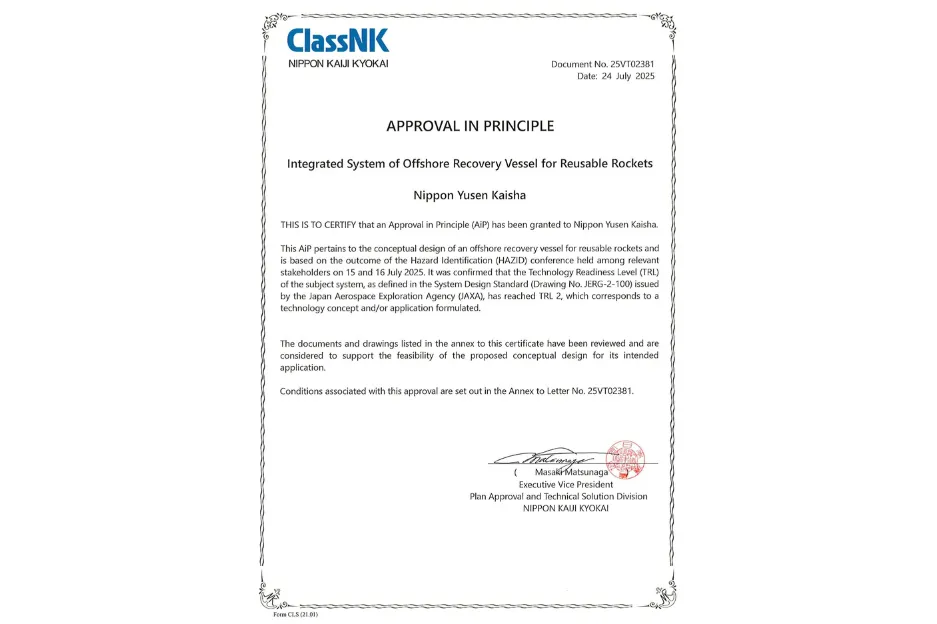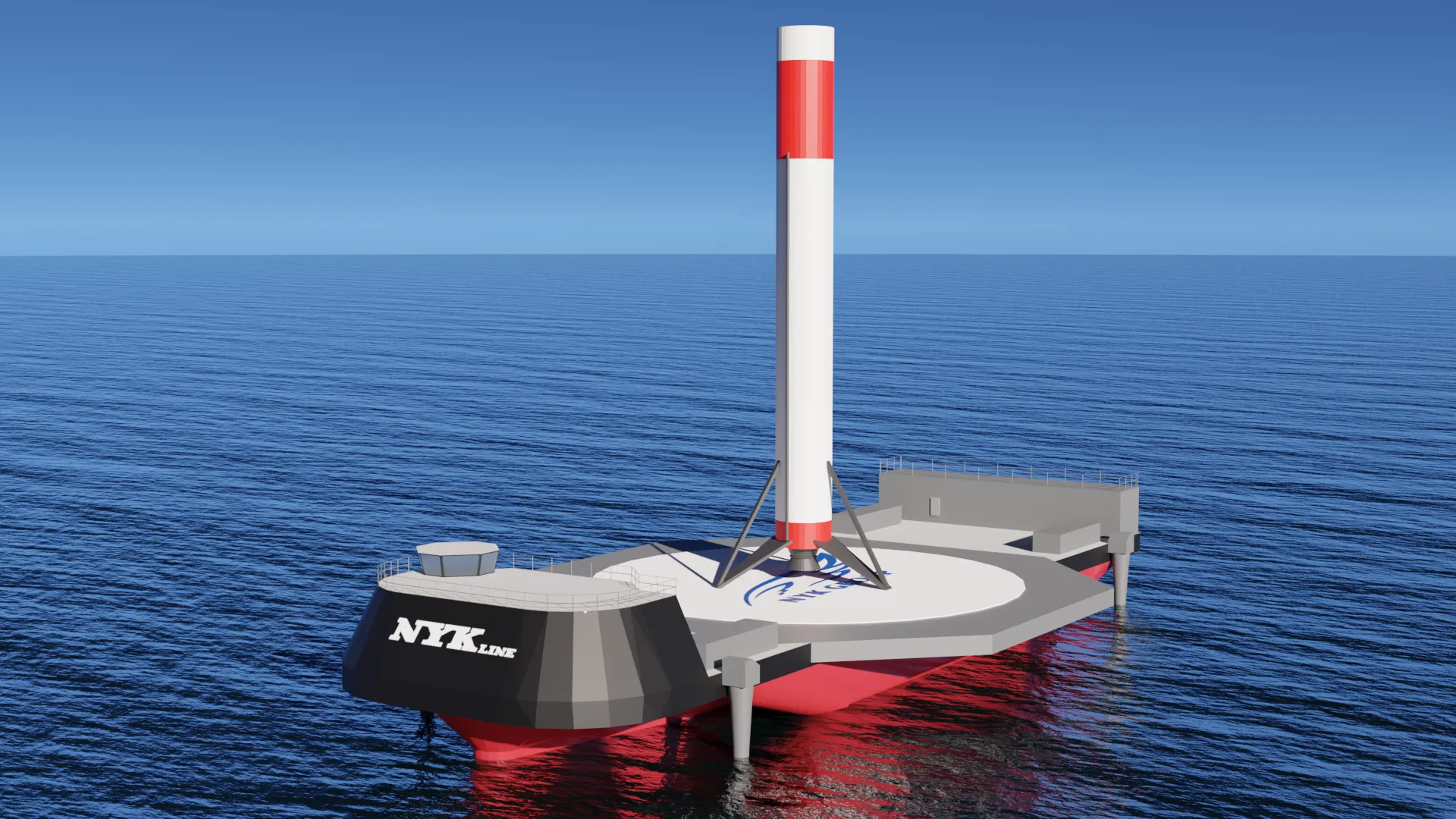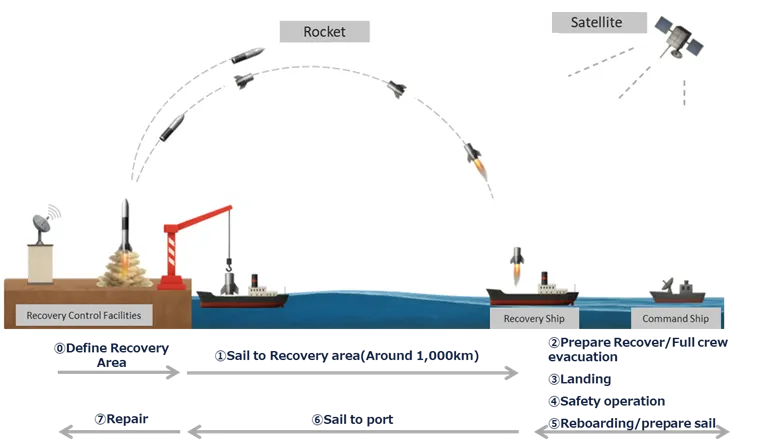Jul. 24, 2025
NYK Obtains Approval in Principle for Offshore Reusable Rocket Recovery System
3D Model Unveiled, Laying Foundation for New Business Opportunities through the Fusion of Ocean and Space
On July 24, NYK obtained Approval in Principle (AiP)* from ClassNK for the conceptual design of an offshore recovery system for reusable rockets, an initiative developed through the Space Strategy Fund at the Japan Aerospace Exploration Agency (JAXA). This significant milestone was achieved through productive discussions with project partners, including Mitsubishi Heavy Industries, Ltd. (MHI) and others, during a workshop held earlier this month. Notably, this marks the first time that ClassNK has granted AiP for a space-related system involving a vessel.
On the same day, NYK held a press briefing at its head office to unveil a 3D model of the offshore recovery system. Based on the model designed, we remain committed to in-depth discussions with stakeholders, aiming to ensure the success of a scheduled demonstration test in fiscal year 2028.
Certificate award ceremony
From left
Shoyo Hyodo, Senior Deputy Manager, Next Generation Launch Vehicle, Space Systems Division, MHI
Masaki Matsunaga, Executive Vice President / Director, Plan Approval and Technical Solution Division, ClassNK
Yasushi Yamamoto, Executive Officer, Technical Group and Engineering Development Group, NYK
Kei Yuhara, General Manager, Innovation Promotion Group, NYK

AiP certificate

Image of recovery vessel

Image of recovery vessel aboard command vessel
Rocket recovery: roles of the recovery vessel and command vessel
Rockets are launched by generating thrust through the combustion of fuel and oxidizer. Following launch, the lower stage (first stage) of the rocket separates from the upper stage and falls back to Earth. Most first stages are expected to be designed with advanced functions to accurately determine the position of the offshore recovery vessel and facilitate automatic landing.
The offshore recovery system comprises two vessels: a recovery vessel, where the first stage of the rocket lands, and a command vessel that supports the recovery operation. The recovery vessel remains stationed at the landing site, serving as the landing location for the falling first stage of the rocket. The recovery vessel is equipped with a Dynamic Positioning System (DPS), enabling it to maintain its position accurately while accounting for factors such as tidal currents. Notably, the recovery vessel will operate entirely unmanned during rocket recovery, and the rocket will be safely secured after landing on the recovery vessel. Once the rocket has landed, the command vessel will coordinate with the recovery vessel to safely transport the rocket back to port.
The offshore recovery process and the accompanying 3D model of the rocket remain in the conceptual stage. Utilizing insights garnered from the recent workshop, we will continue to refine discussions surrounding the vessel type, organizational structure, and overall recovery process for the offshore recovery system.

Flow of offshore recovery system for reusable rockets**
Background and significance
As a maritime nation with limited land area, the development of offshore recovery technologies is gaining attention to ensure the safe and efficient recovery of rockets in Japan. This initiative is integral to Japan's broader space technology strategy. Moreover, the rapidly growing market for space-related industries has prompted a transition from government-led initiatives to public-private partnerships. To foster collaboration among industry, academia, and government, the Japanese government has established the Space Strategy Fund at JAXA to support private companies and other entities in actively pursuing technological development over multiple years for designated technical development themes. On December 20, 2024, NYK was selected by JAXA for a Space Strategy Fund project focused on developing ground-based infrastructure technologies for the recovery of reusable spacecraft (see related link), and we are collaborating with MHI and other partners to research, develop, and commercialize the offshore reusable rocket recovery system, leveraging our extensive knowledge in the maritime field.
Press briefing
Commercialization plan
• Expansion of space-related transportation demand
As the number of rocket launches increases, a corresponding rise in the transportation needs for rocket components and satellites is expected. We intend to leverage our strengths as a comprehensive logistics provider to capture business opportunities related to space development.
• New possibilities through the integration of ocean and space technologies
With advancements in offshore recovery vessel development, we expect an increase in reusable rocket launches, leading to more frequent satellite launches. For example, the enhancement of high-speed communication infrastructure driven by increasing satellite launches will facilitate advancements in autonomous vessel technology and improved convenience for crew members on board. Furthermore, remote sensing satellites*** will make it possible to optimize vessel routes and monitor greenhouse gas emissions from vessels. In this way, “connecting the ocean with space” will yield benefits for both the maritime industry and the space industry, contributing to the further development of Japan as a leading maritime nation.
* Approval in Principle (AiP)
This designation confirms the technical feasibility of the initial concept prior to the basic design phase.
** Flow of offshore recovery system for reusable rockets
The image presented is conceptual, and specifications regarding offshore rocket recovery will be discussed in the future.
*** Remote sensing satellite
An artificial satellite equipped with sensors that provide information on weather and sea conditions by monitoring the Earth's surface.
The news on this website is as of the date announced and may change without notice.